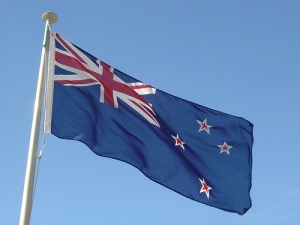Waka Māori draws crowds for living culture

Shaped like a giant version of the traditional Māori waka or canoe, the modern fabric construction occupies a prominent site on the waterfront where it is surrounded by yachts and pleasure boats moored in the busy downtown Viaduct Harbour.
The temporary pavilion, sited alongside a series of smaller venues where Māori artists can be seen at work, has become a must-see attraction since it opened last week, clocking up almost 140,000 visitors over the first three days.
The distinctive waka-shaped venue, which cost NZ$2 million, will be open until the end of the tournament but may appear at other locations in the future.
Māori rugby
The central exhibition space tells the story of Māori rugby and includes a valuable collection of Māori rugby memorabilia. From time to time, there is also the opportunity to brush shoulders with former New Zealand Māori rugby players and All Blacks.
Several well known rugby players have been through the exhibition, including Tana Umaga, Sir Brian Lahore, Todd Blackadder, Eric Rush, Murray Pierce, Bull Allen and John Kirwan.
Māori All Blacks manager Peter Potaka said the exhibition was an emotional experience for some visitors.
“We have even had people in tears as they look for a grandfather or family member’s name on the roll of honour of Māori All Blacks. It has been something quite special,” said Potaka
Māori culture
Outside the waka, at opening time in the morning, visitors can witness a formal Māori powhiri / welcome ceremony.
Inside there are live performances of traditional and contemporary kapa haka, music and dance by some top Māori performers, and a 3D short film that takes the audience back in time to tell the Māori creation story.
In the evenings there are live broadcasts of rugby games.
Village of artisans
Next to the waka, the artisans village is a hive of creative activity and a rare opportunity for visitors to watch and interact with Māori artists as they produce fine traditional and contemporary artworks from wood, greenstone and traditional weaving.
A line-up of traditional ta moko / Māori tattoo artists will satisfy visitors wanting to take home a very personal and unique New Zealand memento.
The final marquee has been set up as a Māori art market selling valuable pieces of traditional and contemporary artworks
ADVERTISEMENT
Culture sharing
Waka Māori provided an opportunity for foreign visitors and New Zealanders to see Māori culture as “a living and breathing part of this country”, according to project director Renata Blair.
It was designed to showcase the mana / pride of Māori arts, culture, rugby, entrepreneurial spirit and business, as well as extending the essence of Māori manaakitanga / hospitality.
“It is a pleasure for Māori to share their culture and for Māori it is a delight to be able to have quality engagement with visitors and have the chance to talk and laugh together,” Blair said.
Waka Māori construction
The Waka Māori pavilion is made of laminated native timber, covered with a skin of tension membrane. It is similar to the giant ‘Cloud’ further along the waterfront which is Auckland’s main Rugby World Cup fan zone.
The venue, which caters for up to 600 people, is 75m long by 16m high with 501 square metres of floor space but can be extended with inserts.
The waka has air-conditioning, staging, lighting, sound and catering facilities.
The Auckland appearance is part of the REAL New Zealand Festival running alongside the Rugby World Cup tournament.
Background: Māori waka
Waka is the Māori word for canoe, but it can also be used to describe any vehicle of conveyance.
For Māori, the waka is a powerful symbol of culture and heritage.
Te Waka-a-Maui is the Māori name for the South Island. A Māori legend tells how the ancient ancestor Maui fished from a waka - the South Island - hauling up his catch - the North Island - from the depths.
Māori are descended from the crew of waka which migrated to New Zealand from across the Pacific. They were accomplished navigators who explored the Pacific in voyaging waka for centuries, and today master navigators continue to pass on their skills.
Visitors to Auckland can sail on the harbour in a traditional Maori double-hulled waka. The Te Aurere operates from a berth beside the Voyager Maritime Museum, in Viaduct Harbour.
City.Mobi
Also in New Zealand today, City.Mobi is celebrating the success of its new guide to Auckland.
City.Mobi offers the most comprehensive mobile travel guides available, with over 800 cities in 200 countries listed. Each is developed by the City.Mobi team to combine into a single global travel directory.
However, each city retains its own mobile identity via a dedicated domain. Already on offer are Brussels.Mobi, Paris.Mobi, Sanfrancisco.Mobi and Sydney.Mobi.
Auckland.mobi is the latest in this illustrious line up, offering click to call functionality – which means no scribbling down telephone numbers.
Most entries are also linked to websites where users can quickly access more detailed information if needed.
Other key features include information on accommodation, restaurants, attractions, entertainment, nightlife, shopping, and transport.
City.Mobi guides include user reviews and traveller utilities such as a translation guide, currency converter, news and local weather guide.

